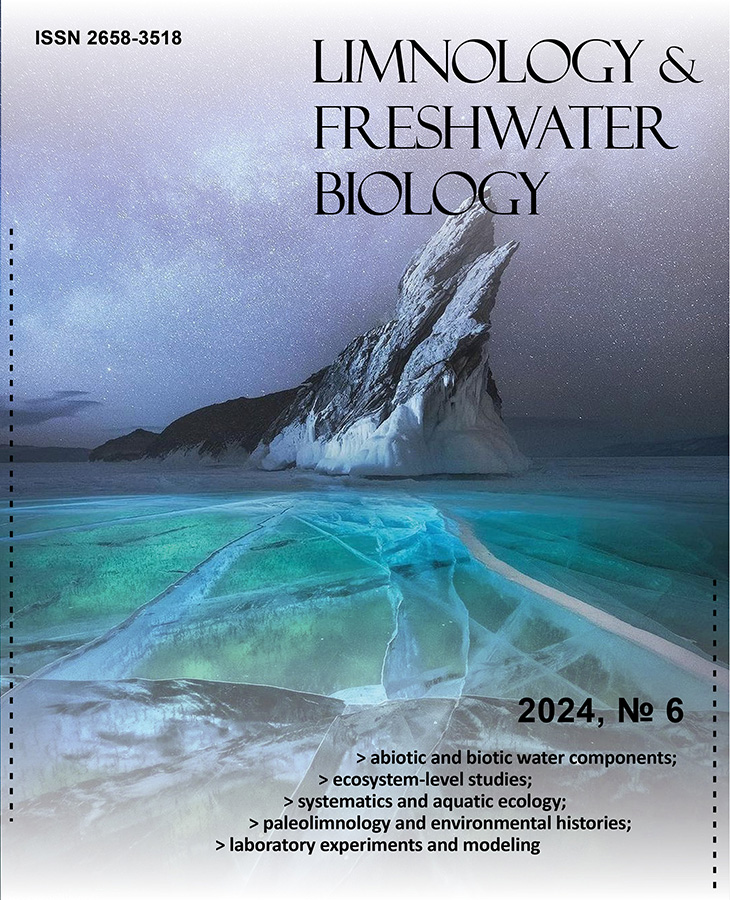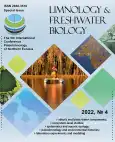A multi-proxy study of Holocene environmental and climate change in the Pechora Delta
- Авторы: Frolova L.A.1, Nigamatzyanova G.R.1, Nigmatullin N.M.1, Valieva E.A.1, Frolova A.A.1
-
Учреждения:
- Kazan Federal University
- Выпуск: № 4 (2022)
- Страницы: 1421-1422
- Раздел: Статьи
- URL: https://journal-vniispk.ru/2658-3518/article/view/288557
- DOI: https://doi.org/10.31951/2658-3518-2022-A-4-1421
- ID: 288557
Цитировать
Полный текст
Аннотация
The Arctic and subarctic regions have been the focus of a great deal of research during the recent years. Their high-latitude areas are thought to play a crucial role in climatic forcing and, thus, may be particularly sensitive to climate change. Arctic freshwater ecosystems are especially susceptible to the negative consequences of global environmental change drivers. Paleoclimatic investigations provide a better insight into the climate and environmental situation of certain regions and water objects in the past and help to predict their future changes, as well as to identify the development trends of the Earth’s climate as a whole. The multy-proxy study of 96-cm long sediment core obtained in Lake Arcto-Pimberto (68°26.114′ N, 053°32.311′ E, the Pechora River delta, Nenets Autonomous Okrug) reflect regional paleoecological and climate changes in the north of the Eastern European plain over the last 6400 year. Based on the subfossil Cladocera, diatom and palynological analysis of the bottom sediment of the arctic lake Arkto-Pimberto, we received preliminary information on environmental and climatic changes, as well as on changes in vegetation character in the area around the water body.
Ключевые слова
Полный текст
1. Introduction
Lake sediments contain a variety of organic and inorganic remains that may be used to track the history of a lake or its catchment. Diatoms, cladocera, and remains of plants are used as indicator groups in paleoecological studies (Frolova, 2018; Nigmatullin et al., 2021). The aim of this work is a paleoecological reconstruction of the development of the Arctic lake Arktо-Pimberto using multy-proxy analysis.
2. Materials and methods
The investigated lake is located in the delta of the Pechora River, the largest river in the European North of Russia that flows into the Barents Sea. The region is an alluvial plain consisting of numerous large and small islands. A 96-cm-long core of bottom sediments was recovered from the central part of Lake Arkto-Pimberto during the summer expedition in 2018. For paleobiological analysis were used samples taken at 1-2 cm intervals.
For pollen analysis treatment of the samples was carried out with the help of the Faegri–Iversen method, but without the acetolysis stage (Faegri and Iversen, 1989). All diatoms samples were processed by the standard methods using 37% hydrogen peroxide as an oxidant of the organic matter present in the samples, including 10% HCl treatment in order to remove calcium carbonate, followed by rinsing with distilled water (Battarbee, 1986). The sediment samples for Cladocera analysis were studied using the standard techniques (Korhola and Rautio, 2001; Szeroczyńska and Sarmaja-Korjonen, 2007). Microscopic examinations were made at x100-400 magnification under a light microscope Axio Imager A2 (Carl Zeiss, Germany).
3. Results and discussion
As a result of the diatom study, 113 diatom taxa comprising 44 genera were identified in the fossil diatom flora. The ecological and geographical analysis of the species composition showed the dominance of Holarctic, benthic, and alkaliphilic species with the abundance growth under moderate temperatures. With the help of the cluster analysis, the entire core was divided into three zones based on the presence of diatom taxa and their relative abundance. The first zone corresponds to the stage when the lake was characterized by the mass development and diversity of diatoms, thereby reflecting the period of the high water level and the formation of a deep and less mineralized water body. Diatoms were present in small number or absolutely absent in the middle layers of the core. In the upper part of the core, there is significant an increase in the number of diatoms.
A total of 16 cladoceran taxa were found in sediment. In general, the crustacean remains were distributed evenly throughout the core. Bosmina (Eubosmina) longispina, the cold-water taxon characteristic of oligotrophic water bodies, was absolutely dominant in all stratigraphic zones. The complex of subdominant species included Chydorus cf. sphaericus, Alona affinis, and Rhynchotalona falcata. The species diversity of Lake Arkto-Pimberto is determined mostly by northern species. The dominant position of littoral taxa indicates the prevalence of the littoral zone in the lake. The species diversity of cladocerans was low. No significant changes were observed in the development of cladoceran communities. The historical formation of Lake Arkto-Pimberto was uniform in different zones. Based on the Shannon index, the lake is β-mesotrophic. According to the Pantle–Buck index modified by Sladecek, the lake is oligosaprobic.
The spore-pollen spectrum from the sediments were dominated by arboreal taxa. Pollen of Betula sp., Cyperaceae and Sphagnum spore were present throughout the core in relatively constant percentages. Four palynological zones are definable under consideration on the basis of the spore-pollen. The spore-pollen spectra from the PZ I are characterized by a prevailing share of arboreal taxa pollen mostly represented by Betula spp., Salix, Alnaster with the presence of heather (Ericaceae) communities. The PZ I was deposited in wetter conditions. The spore-pollen spectra from the middle layers of the core (PZ II PZ III) are characterized by an increased concentration of herbaceous taxa pollen. The pollen spectrum from the PZ IV reflects the development of moss and low-growing shrubs in wet climates.
4. Conclusions
We analyzed the structure of the subfossil cladoceran community, pollen and diatoms in sediments of Lake Arkto-Pimberto in the Pechora River delta. The predominance of pollen of arboreal taxa is a distinctive features of the spore-pollen spectra of lake sediments. The pollen content of non-arboreal taxa is 10-20%. The pollen of Betula spp., Cyperaceae and Sphagnum spp. has a more or less constant percentage throughout the core. A total of 16 cladoceran taxa were found in sediment core 18-Pe-01C. In general, the crustacean remains were distributed evenly throughout the core. Bosmina (Eubosmina) longispina, the cold-water taxon characteristic of oligotrophic water bodies, was absolutely dominant in all stratigraphic zones. Based on the Shannon index, the lake is β-mesotrophic. According to the Pantle–Buck index modified by Sladecek, the lake is oligosaprobic.
The ecological and geographical analysis of the diatom species composition showed the dominance of Holarctic, benthic, and alkaliphilic species with the abundance growth under moderate temperatures. With the help of the cluster analysis, the entire core was divided into three zones based on the presence of diatom taxa and their relative abundance. The first zone corresponds to the stage when the lake was characterized by the mass development and diversity of diatoms, thereby reflecting the period of the high water level and the formation of a deep and less mineralized water body. Diatoms were present in small number or absolutely absent in the middle layers of the core. In the upper part of the core, there is significant an increase in the number of diatoms.
Acknowledgements
The paleobiological analysis was supported by grant from Russian Scientific Foundation (No 20-17-00135). The statistical analysis has been conducted at the expense of funds of the subsidy allocated to Kazan Federal University for the state assignment #671-2020-0049 in the sphere of scientific activities and by the Kazan Federal University Strategic Academic Leadership Program.
Conflict of interest
Authors declare no conflict of interest.
Об авторах
L. Frolova
Kazan Federal University
Автор, ответственный за переписку.
Email: larissa.frolova@kpfu.ru
Россия, 18 Kremlevskaya str., Kazan, 420008
G. Nigamatzyanova
Kazan Federal University
Email: larissa.frolova@kpfu.ru
Россия, 18 Kremlevskaya str., Kazan, 420008
N. Nigmatullin
Kazan Federal University
Email: larissa.frolova@kpfu.ru
Россия, 18 Kremlevskaya str., Kazan, 420008
E. Valieva
Kazan Federal University
Email: larissa.frolova@kpfu.ru
Россия, 18 Kremlevskaya str., Kazan, 420008
A. Frolova
Kazan Federal University
Email: larissa.frolova@kpfu.ru
Россия, 18 Kremlevskaya str., Kazan, 420008
Список литературы
- Battarbee R.W. 1986. Diatom analysis. In: Berglund B.E. (Ed.), Handbook of Holocene paleoecology and palaeohydrology. Chichester: John Wiley and Sons, pp. 527-570.
- Faegri K., Iversen J. 1989. Textbook of pollen analysis. Chichester: John Wiley and Sons.
- Frolova L.A. 2018. Cladocera from bottom deposits as an indicator of changes in climate and ecological conditions. IOP Conference Series: Earth and Environmental Science 107: 012084. doi: 10.1088/1755-1315/107/1/012084
- Korhola A., Rautio M. 2001. Cladocera and other branchiopod crustaceans. In: Smol J.P., Birks J.B., Last W.M. (Eds.), Tracking environmental change using lake sediments. Vol.: Zoological indicators. Netherlands: Kluwer Academic Publishers, pp. 5-41.
- Nigmatullin N.M., Nigamatzyanova G.R., Valieva E.A. et al. 2021. Recent Cladocera (Branchiopoda, Crustacea) in the Taphocenoses of lakes of the Pechora River delta (Russia), Uchenye Zapiski Kazanskogo Universiteta. Seriya Estestvennye Nauki [Scientists Notes of Kazan University. Series Natural Sciences] 163(3): 527-537. (in Russian)
- Szeroczyńska K., Sarmaja-Korjonen K. 2007. Atlas of Subfossil Cladocera from Central and Northern Europe. Poland: Friends of the Lower Vistula Society.
Дополнительные файлы










